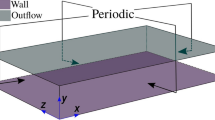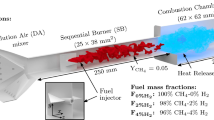Abstract
Development of turbulent diffuse flame in a compartment with a vertical opening is studied experimentally and numerically. Flame projection through the opening observed under conditions of limited natural‐convective ventilation is considered. The measurements are performed in a laboratory box designed for compartment‐fire simulation. The critical (minimum) flow rate of the fuel sufficient for flame projection is determined, as well as the delay between fuel ignition and flame projection with subsequent establishment of external combustion. Dimensionless variables for processing experimental data are proposed. A generic empirical dependence of the dimensionless time of flame projection on the dimensionless flow rate of the fuel is obtained for various opening sizes, burner positions, and box sizes. The dimensionless critical flow rate of the fuel obtained is in agreement with the previously published measurements performed for gaseous and condensed fuels. Unsteady stages of flame evolution before the projection and scenarios of flame projection through the opening are identified and analyzed. A three‐dimensional numerical model is developed for calculating turbulent diffusion combustion in a compartment with an opening. The model takes into account the conjugate radiative‐convective heat transfer on solid surfaces and the thermal conductivity of the wall and floor materials. The experimentally observed stages of flame development, flame projection through the opening, and stabilization of external combustion are reproduced in numerical calculations. The numerical values of flame‐projection time are in good agreement with the measurement results and proposed empirical relation.
Similar content being viewed by others
REFERENCES
M. L. Bullen and P. H. Thomas, “Compartment fires with non-cellulosic fuels,” in: 17th Symp. (Int.) on Combustion, The Combust. Inst. (1978), pp. 1139–1148
D. Drysdale, An Introduction to Fire Dynamics, Wiley (1999).
L. S. Seigel, “The projection of ames from burning buildings,” Fire Technol., No. 5, 43–51 (1969).
P. H. Thomas and M. Law, “The projection of flames from buildings on fire,” Fire Prevention Sci. Technol., No. 10, 19–26 (1972).
I. Oleszkiewicz, “Heat transfer from a window fire plume to a building facade,” in: Proc. of the ASME Heat Transfer Division, HTD, Vol. 123 (1989), pp. 163–170.
G. D. Lougheed and D. Yung, “Exposure to adjacent structures from ames issuing from a compartment opening,” in: Proc. of the 6th Int. Conf. Interam '93 (1993), pp. 297–306.
S. Klopovic and O. F. Turan, “A comprehensive study of externally venting ames. Part I: Experimental plume characteristics for through-draft and no-through-draft ventilation conditions and repeatability,” Fire Safety J., 36, 99–133 (2001).
S. Klopovic and O. F. Turan, “A comprehensive study of externally venting ames. Part II: Plume envelope and centre-line temperature comparisons, secondary fires, wind effects and smoke management system,” Fire Safety J., 36, 135–172 (2001).
B. Bohm and B. M. Rasmussen, “The development of a small-scale fire compartment in order to determine thermal exposure inside and outside buildings,” Fire Safety J., 12, 103–108 (1988).
D. T. Gottuk, R. J. Roby, and C. L. Beyler, “A study of carbon monoxide and smoke yields from compartment fires with external burning,” in: 24th Symp. (Int.) on Combustion, The Combust. Inst. (1992), pp. 1729–1735.
A. Yu. Snegirev, G. M. Makhviladze, and J. Roberts, “Numerical simulation of diffuse turbulent combustion in different compartment-fire modes,” in: Proc. 2nd Russian National Conf. on Heat Transfer, Vol. 3: Natural Convection. Heat Transfer With Chemical Reactions [in Russian], Izd. Mosk. Énerg. Inst., Moscow (1998), pp. 273–276.
J. X. Wen and L. Y. Huang, “CFD modelling of confined jet fires under ventilation-controlled conditions,” Fire Safety J., 34, 1–24 (2000).
V. Babrauskas and R. B. Williamson, “Post-ashover compartment fires: Basis of a theoretical model,” Fire Mater., No. 2, 39–53 (1978).
Yu. A. Koshmarov and M. P. Bashkirtsev, Thermodynamics and Heat Transfer in Fire Activities [in Russian], Izd. Vyssh. Pozh.-Tekh. Shk., Moscow (1987).
Yu. V. Lapin and M. Kh. Strelets, Internal Flows of Gas Mixtures [in Russian], Nauka, Moscow (1989).
G. Cox (ed.), Combustion Fundamentals of Fire, Academic Press, London (1995).
B. F. Magnussen and B. H. Hjertager, “On mathematical modeling of turbulent combustion with special emphasis on soot formation and combustion,” in: 16th Symp. (Int.) on Combustion, The Combust. Inst. (1977), pp. 719–728.
I. M. Khan and G. Greeves, “A method for calculating the formation and combustion of soot in diesel engines,” in: N. H. Afgan and J. M. Beer (eds.), Heat Transfer in Flames, Scripta Book Company, Wiley, New York (1974), pp. 389–404.
A. Yu. Snegirev, G. M. Makhviladze, and V. A. Talalov, “Statistical modelling of thermal radiation in compartment fire,” in: Proc. of the 9th Int. Conf. Interam, Vol. 2 (2001), pp. 1011–1024.
T. F. Smith, Z. F. Shen, and J. N. Friedman, “Evaluation of coefficients for the weighted sum of gray gases model,” Trans. ASME, J. Heat Transfer, 104, 602–608 (1982).
T. F. Smith, A. M. Al-Turki, K.-H. Byun, and T. K. Kim, “Radiative and conductive transfer for a gas/soot mixture between diffuse parallel plates,” J. Thermophys. Heat Transfer, No. 1, 50–55 (1987).
B. Marracino and D. Lentini, “Radiation modelling in non-luminous nonpremixed turbulent flames,” Combust. Sci. Technol., 128, 23–48 (1997).
J. H. Ferziger and M. Peric, Computational Methods for Fluid Dynamics, Springer-Verlag, Berlin (1999).
S. McCormick and J. Ruge, “Algebraic multigrid methods applied to problems in computational structural mechanics,” in: A. K. Noor and J. T. Oden (eds.), State-of-the-Art Surveys on Computational Mechanics, ASME (1989), pp. 237–270.
Author information
Authors and Affiliations
Rights and permissions
About this article
Cite this article
Snegirev, A.Y., Makhviladze, G.M., Talalov, V.A. et al. Turbulent Diffusion Combustion under Conditions of Limited Ventilation: Flame Projection Through an Opening. Combustion, Explosion, and Shock Waves 39, 1–10 (2003). https://doi.org/10.1023/A:1022189816023
Issue Date:
DOI: https://doi.org/10.1023/A:1022189816023




